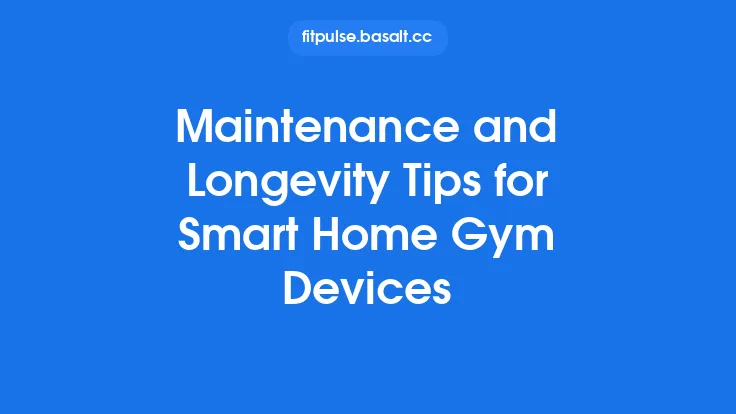Smart fitness devices—such as connected dumbbells, AI‑driven rowing machines, and interactive cardio consoles—are becoming staples of modern home gyms. While their convenience and data‑rich feedback are undeniable, the energy they draw can add up, especially in households that already host multiple smart appliances. By adopting energy‑efficient practices, users can keep their workouts sustainable, reduce electricity bills, and extend the lifespan of battery‑powered gear. Below is a comprehensive guide that walks through the technical and behavioral steps anyone can take to make a smart home gym greener.
Understanding Power Consumption in Smart Fitness Devices
Baseline vs. Active Power
- Idle (standby) power: Even when not in use, many devices keep microcontrollers, Wi‑Fi modules, and sensors powered to stay “ready.” Typical idle draws range from 0.2 W (low‑end smart mats) to 2 W (high‑resolution smart mirrors).
- Active power: During a workout, power spikes as motors, displays, and haptic feedback engage. For example, a smart stationary bike may draw 30–80 W while pedaling, whereas a connected resistance band system stays under 5 W.
Energy‑intensive subsystems
- Motors & actuators – The biggest consumers; efficiency hinges on motor type (brushless DC vs. brushed) and control algorithms.
- Displays – LCDs with backlights consume more than e‑ink or low‑power OLED panels.
- Wireless radios – Wi‑Fi (2.4 GHz) typically uses 0.5–1 W during transmission; Bluetooth Low Energy (BLE) can stay under 0.1 W.
- Sensors – Accelerometers and gyroscopes are low‑power, but continuous high‑frequency sampling can add up.
Understanding where the wattage goes is the first step toward targeted reductions.
Design Strategies for Low Energy Use
Hardware choices
- Brushless DC (BLDC) motors: Offer higher torque per watt and regenerative braking capabilities, feeding energy back into the system during deceleration.
- Efficient power supplies: Look for devices certified with 80 PLUS or similar standards; they waste less heat and draw less current from the mains.
- Low‑power microcontrollers: ARM Cortex‑M series chips can enter deep‑sleep modes in milliseconds, slashing idle draw.
Component integration
- Sensor fusion: Combine data from multiple low‑power sensors to replace a single high‑power sensor (e.g., using a magnetometer instead of a high‑resolution camera for position tracking).
- Dynamic voltage and frequency scaling (DVFS): Adjust CPU clock speeds based on workload; a device can run at 0.8 GHz during warm‑up and ramp to 1.6 GHz only when processing heavy AI inference.
Mechanical design
- Optimized gearing: Proper gear ratios reduce motor load, especially in resistance‑based equipment.
- Friction reduction: Use high‑quality bearings and lubricants to minimize energy lost to heat.
Optimizing Device Settings for Energy Savings
- Screen timeout – Set displays to dim after 30 seconds of inactivity; many devices allow custom timeout intervals.
- Brightness control – Use ambient light sensors to auto‑adjust backlight levels; a 50 % reduction in brightness can cut display power by up to 30 %.
- Power‑save modes – Many smart equipment offer “Eco” or “Low‑Power” workout profiles that limit motor torque and reduce sensor sampling rates without compromising core functionality.
- Automatic sleep – Enable features that fully power down the device after a short period of inactivity (e.g., 2 minutes).
These adjustments are often accessible through the companion app or on‑device menus.
Smart Scheduling and Usage Patterns
Batch workouts – Group multiple short sessions into a single longer workout to avoid repeated power‑up cycles. Each start‑up incurs a brief surge in power consumption; consolidating sessions reduces cumulative surges.
Off‑peak operation – If your utility offers time‑of‑use rates, schedule high‑draw activities (e.g., long rowing sessions) during lower‑cost periods. Many devices can be programmed via their apps to start automatically at a chosen time.
Load balancing – In homes with several smart gym devices, stagger their active periods to avoid simultaneous peaks that could stress the household circuit and increase overall demand charges.
Battery Management and Longevity
For cordless equipment (e.g., smart kettlebells, wireless heart‑rate straps), battery health directly influences energy efficiency.
- Charge cycles – Lithium‑ion cells perform best when kept between 20 % and 80 % state‑of‑charge. Deep discharges and constant 100 % charging accelerate capacity loss, leading to higher internal resistance and more heat generation.
- Temperature control – Store and use batteries in environments between 15 °C and 25 °C. Elevated temperatures increase self‑discharge rates and reduce overall efficiency.
- Smart charging – Use chargers that support constant‑current/constant‑voltage (CC/CV) profiles and stop charging once the optimal voltage is reached. Some devices incorporate “trickle‑charge” modes that maintain a small charge without over‑charging.
Proper battery stewardship not only extends runtime but also reduces the frequency of replacements, cutting waste.
Energy Harvesting and Renewable Integration
Regenerative braking – Devices with moving parts (e.g., smart bikes, ellipticals) can capture kinetic energy during deceleration. The recovered electricity can recharge internal batteries or offset mains consumption. Look for models that advertise “energy‑recovery” percentages; even a modest 5 % recovery translates to noticeable savings over months of use.
Solar‑assisted power – For home gyms with ample natural light, small photovoltaic panels can be installed on windows or roof overhangs to feed low‑power devices (e.g., smart mats, sensor hubs). A 10 W solar panel can sustain a device that draws 2 W continuously, especially when paired with a small battery buffer.
Piezoelectric flooring – Emerging floor tiles generate electricity from footfalls. While still niche, integrating such tiles beneath a workout area can provide supplemental power for low‑draw sensors and lighting.
Network and Connectivity Efficiency
Even though a separate article covers connectivity options, focusing on how to use those connections efficiently is still within scope.
- Batch data transmission – Instead of streaming sensor data in real time, configure the device to buffer and send data in intervals (e.g., every 5 minutes). This reduces the number of Wi‑Fi radio activations, cutting transmission energy by up to 40 %.
- Local processing – Perform on‑device analytics (e.g., rep counting, cadence calculation) rather than sending raw data to the cloud. Edge computing reduces network traffic and associated power draw.
- Adaptive radio power – Devices that can lower Wi‑Fi transmit power when the router is nearby (signal strength > -50 dBm) conserve energy without sacrificing reliability.
Software and Firmware Optimization
Efficient code paths – Developers can minimize CPU cycles by using fixed‑point arithmetic instead of floating‑point where possible, and by leveraging hardware accelerators for AI inference. Fewer cycles mean lower power consumption.
Over‑the‑air (OTA) updates – Schedule firmware updates during low‑usage periods and ensure they are delta‑updates (only changed bytes) rather than full image flashes. This reduces the amount of data transferred and the time the radio stays active.
Power‑aware APIs – When building custom workout apps, use platform‑provided power‑aware APIs that automatically throttle sensor sampling based on activity level.
User Education and Best Practices
- Turn off devices when not in use – Even if a device appears “sleeping,” unplugging it or using a smart power strip can eliminate phantom loads.
- Maintain proper ventilation – Overheating forces cooling fans to run, increasing power draw. Keep equipment in well‑ventilated spaces.
- Regular firmware checks – Updates often include energy‑efficiency patches; staying current ensures you benefit from the latest optimizations.
- Use the companion app’s energy dashboard – Many manufacturers now provide a “energy usage” view that shows daily, weekly, and monthly consumption, helping users identify high‑usage patterns.
Future‑Proofing Energy Efficiency
While the article avoids speculative trends, it is worthwhile to note that many manufacturers are adopting energy‑first design philosophies that will become standard. When purchasing new equipment, look for:
- Energy‑Star or equivalent certifications for home appliances.
- Modular battery packs that can be swapped for higher‑capacity units without replacing the entire device.
- Open‑source firmware that allows community‑driven power‑optimizations.
Choosing devices built with these principles ensures that your smart gym remains efficient as technology evolves.
Closing Thoughts
Smart fitness devices bring unparalleled convenience and data to home workouts, but they also introduce new energy demands. By understanding where power is consumed, selecting hardware and settings that prioritize efficiency, managing batteries wisely, and adopting smart usage habits, you can enjoy a high‑tech gym without inflating your electricity bill or carbon footprint. Implementing these practices not only benefits the environment but also prolongs the life of your equipment—making every rep, row, and sprint both effective and sustainable.





